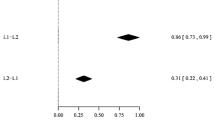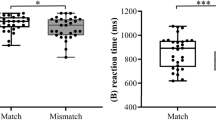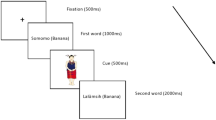Abstract
The present study aimed to test the Sense Model of cross-linguistic masked translation priming asymmetry, proposed by Finkbeiner et al. (J Mem Lang 51:1–22, 2004), by manipulating the number of senses that bilingual participants associated with words from both languages. Three lexical decision experiments were conducted with Chinese-English bilinguals. In Experiment 1, polysemous L2 words and their L1 Chinese single-sense translation equivalents were selected as primes and targets. In Experiment 2, single-sense L1 words and their L2 translation equivalents with polysemous senses severed as primes and targets. We found translation priming effects in the L1–L2 direction, but not in the L2–L1 direction. In Experiment 3, presentation time of the L2 priming stimulus was prolonged, and significant translation priming effects were observed in the L2–L1 direction. These findings suggest that the Sense Model does not adequately explain cross-language translation priming asymmetry. The sense numbers of primes and targets, as well as the activation proportion of these senses between them, were possibly not the primary reason for cross-language translation priming asymmetry. The revised hierarchical model (Kroll and Stewart in J Mem Lang 33:149–174, 1994) and the BIA+ model (Dijkstra and van Heuven in Bilingualism Lang Cognit 5:175–197, 2002) better explain the cross-language translation priming asymmetry we found.
Similar content being viewed by others
Notes
Rodd et al. (2002) regarded a word with only one entry in the Wordsmyth Dictionary (http://www.wordsmyth.net/) as polysemous with related meanings, whereas a word with more than two entries was regarded as having different meanings. Of our 28 prime stimuli, only the word “key” has two entries in the Wordsmyth Dictionary, but the meaning of one of the two entries is very rare. Thus, the word “key” can also be regarded as polysemous. Therefore, all the 28 prime stimuli in the present study are polysemous words.
References
Basnight-Brown, D. M., & Altarriba, J. (2007). Differences in semantic and translation priming across languages: The role of language direction and language dominance. Memory & Cognition, 35, 953–965.
Brysbaert, M., & New, B. (2009). Moving beyond Kučera and Francis: A critical evaluation of current word frequency norms and the introduction of a new and improved word frequency measure for American English. Behavior Research Methods, 41(4), 977–990.
Cai, Q., & Brysbaert, M. (2010). SUBTLEX-CH: Chinese word and character frequencies based on film subtitles. PloS One, 5(6), 10729.
Davis, C., Sánchez-Casas, R., García-Albea, J., Guasch, M., Molero, M., & Ferré, P. (2010). Masked translation priming: Varying language experience and word type with Spanish-English bilinguals. Bilingualism: Language and Cognition, 13, 137–155.
De Groot, A. M. B., & Nas, G. L. J. (1991). Lexical representation of cognates and noncognates in compound bilinguals. Journal of Memory and Language, 30, 90–123.
de Groot, A. M. B. (1992a). Bilingual lexical representation: A closer look at conceptual representations. In R. Frost & L. Katz (Eds.), Orthography, phonology, morphology, and meaning (pp. 389–412). Amsterdam: Elsevier.
de Groot, A. M. B. (1992b). Determinants of word translation. Journal of Experimental Psychology: Learning, Memory, & Cognition, 18, 1001–1018.
Dijkstra, T., & van Heuven, W. J. B. (2002). The architecture of the bilingual word recognition system: From identification to decision. Bilingualism: Language and Cognition, 5, 175–197.
Dimitropoulou, M., Duñabeitia, J. A., & Carreiras, M. (2011). Masked translation priming effects with low proficient bilinguals? Memory & Cognition, 39, 260–275.
Duñabeitia, J. A., Perea, M., & Carreiras, M. (2010). Masked translation priming effects with highly proficient simultaneous bilinguals. Experimental Psychology, 57(2), 98–107.
Duyck, W., & Brysbaert, M. (2004). Forward and backward number translation requires conceptual mediation in both balanced and unbalanced bilinguals. Journal of Experimental Psychology: Human Perception & Performance, 30, 889–906.
Duyck, W., & Warlop, N. (2009). Translation priming between the native language and a second language. Experimental Psychology, 56(3), 173–179.
Finkbeiner, M., Forster, K., Nicol, J., & Nakamura, K. (2004). The role of polysemy in masked semantic and translation priming. Journal of Memory and Language, 51, 1–22.
Gollan, T. H., Forster, K. I., & Frost, R. (1997). Translation priming with different scripts: Masked priming with cognates and noncognates in Hebrew-English bilinguals. Journal of Experimental Psychology: Learning, Memory, and Cognition, 23, 1122–1139.
Hino, Y., & Lupker, S. J. (1996). Effects of polysemy in lexical decision and naming: An alternative to lexical access accounts. Journal of Experimental Psychology: Human Perception and Performance, 22(6), 1331–1356.
Jiang, N. (1999). Testing processing explanations for the asymmetry in masked cross-language priming. Bilingualism: Language and Cognition, 2, 59–75.
Jiang, N., & Forster, K. I. (2001). Cross-language priming asymmetries in lexical decision and episodic recognition. Journal of Memory and Language, 44, 32–51.
Keatley, C. W., Spinks, J. A., & De Gelder, B. (1994). Asymmetrical cross-language priming effects. Memory & Cognition, 22, 70–84.
Kroll, J. F., & Stewart, E. (1994). Category interference in translation and picture naming: Evidence for asymmetric connections between bilingual memory representations. Journal of Memory and Language, 33, 149–174.
Modern Chinese Dictionary. (1994). Beijing, China: The Commercial Press.
Pexman, P. M., Holyk, G. G., & Monfils, M. H. (2003). Number-of-features effects and semantic processing. Memory & Cognition, 31, 842–855.
Pexman, P. M., Hargreaves, I. S., Siakaluk, P. D., Bodner, G. E., & Pope, J. (2008). There are many ways to be rich: Effects of three measures of semantic richness on visual word recognition. Psychonomic Bulletin & Review, 15(1), 161–167.
Reyna, V. F. (1987). Understanding verbs: Easy extension, hard comprehension. In A. E. Ellis (Ed.), Progress in the psychology of language (pp. 301–315). London: Lawrence Erlbaum.
Rodd, J., Gaskell, G., & Marslen-Wilson, W. (2002). Making senses of semantic ambiguity: Semantic competition in lexical access. Journal of Memory and Language, 46, 245–266.
Sánchez-Casas, R. M., García-Albea, J. E., & Davis, C. W. (1992). Bilingual lexical processing: Exploring the cognate/noncognate distinction. European Journal of Cognitive Psychology, 4, 293–310.
Schoonbaert, S., Duyck, W., Brysbaert, M., & Hartsuiker, R. J. (2009). Semantic and translation priming from a first language to a second and back: Making sense of the findings. Memory & Cognition, 37(5), 569–586.
Taylor, I., & Taylor, M. M. (1990). Psycholinguistics: Learning and using language. Englewood Cliffs, NJ: Prentice-Hall.
Tokowicz, N., Kroll, J. F., De Groot, A. M. B., & Van Hell, J. G. (2002). Number-of-translation norms for Dutch-English translation pairs: A new tool for examining language production. Behavior Research Methods, Instruments, Computers, 34, 435–451.
van Hell, J. G., & de Groot, A. M. B. (1998). Conceptual representation in bilingual memory: Effects of concreteness and cognate status in word association. Bilingualism: Language & Cognition, 1, 193–211.
Wang, X., & Forster, K. (2010). Masked translation priming with semantic categorization: Test the Sense Model. Bilingualism: Language and Cognition, 13(3), 327–340.
Acknowledgments
This research was supported by the fund of The National Social Science Fund (11BYY039), the Central University Basic Scientific Research Fund, the Program for New Century Excellent Talents of Ministry of Education in China (NECT-11-0028) and the Beijing Key Lab of Applied Experimental Psychology.
Author information
Authors and Affiliations
Corresponding author
Rights and permissions
About this article
Cite this article
Chen, B., Zhou, H., Gao, Y. et al. Cross-Language Translation Priming Asymmetry with Chinese-English Bilinguals: A Test of the Sense Model. J Psycholinguist Res 43, 225–240 (2014). https://doi.org/10.1007/s10936-013-9249-3
Published:
Issue Date:
DOI: https://doi.org/10.1007/s10936-013-9249-3




